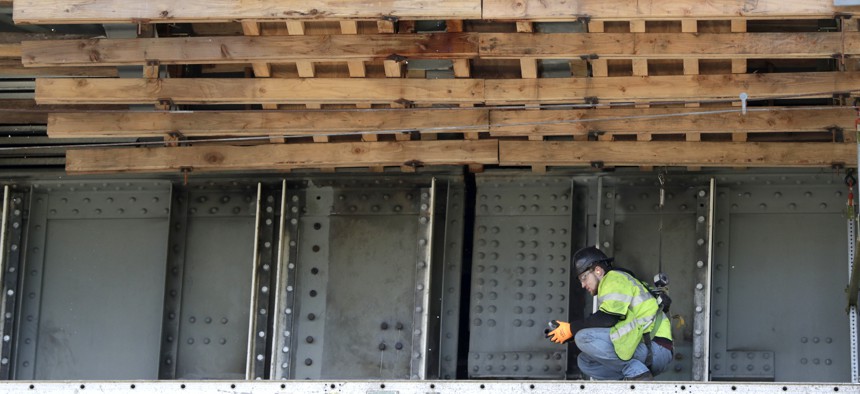$5.6B in Earmarks Included in Transportation Bill

A worker labors on the beam of the Route 495 viaduct during a project to remodel the bridge which feeds into the Lincoln Tunnel in North Bergen, N.J., Tuesday, April 23, 2019. AP Photo/Julio Cortez
The 1,473 local projects funded in the bill range from a transportation center adjacent to the San Diego airport to a paved bike lane in New Jersey.
This post was updated to reflect the House Transportation and Infrastructure Committee's approval of the bill.
More than 1,400 local projects are included in the surface transportation bill the House Transportation and Infrastructure Committee advanced early Thursday.
The list of projects, which equate to roughly $5.6 billion in earmarks, were chosen from more than 2,400 project requests submitted by members of Congress. The projects span 46 states and several territories and range from complicated transit center developments to construction of sidewalks or roundabouts.
The earmarks are included in House Democrats’ $547 billion transportation proposal, which would allocate funding for bridges, roads, transit and railways over the next five years.
Oft-criticized earmarks have not been included in a surface transportation bill since 2005, but lawmakers have taken steps this time to incorporate more documentation and transparency into the process, said Susan Howard, the program director for transportation finance with the American Association of State Highway and Transportation Officials.
The largest of the 1,473 earmarks included in the bill is $25 million for San Diego, California’s Central Mobility Hub, a project that would create a transportation center adjacent to the San Diego International Airport. The bill would provide $20 million to another 25 other projects, including three in California, Minnesota and Texas, and two in Florida and Nebraska.
Lawmakers did not nominate projects in Montana, North Dakota, South Dakota and Wyoming, according to the project database, and no awards were granted for projects in those states.
Many local projects included in the bill received more modest amounts, including:
- $5.6 million for replacement of a 232-foot-long bridge in Superior, West Virginia.
- $774,000 for construction of electric vehicle charging stations in Indianapolis, Indiana.
- $800,000 for a paved bike lane in Woodbine, New Jersey.
- $5.3 million for road widening and reconstruction in Ammon, Idaho.
California had the most earmarked projects (218), followed by Illinois (115) and New York (86). The list of projects is included in an amended version of the bill that transportation committee Chairman Peter DeFazio, an Oregon Democrat, released Monday. (The list of projects spans 133 pages in the 1,383-page bill.)
DeFazio and Ranking Member Sam Graves, a Missouri Republican, agreed to reinstitute the earmark process, but are requiring more documentation and transparency on nominated projects. Nominating lawmakers were required to provide letters of support for the projects, to disclose other sources of funding and the full cost of the projects, and to provide information on the planning stage and phase of the projects.
“I believe this process has allowed us to elevate the greatest needs of communities across the country—each of whom have real infrastructure needs and are entitled to have those needs supported by this legislation,” DeFazio said Wednesday at the start of the markup.
Lawmakers considered dozens of amendments to the bill during Wednesday's markup hearing, which continued into early Thursday.
The committee ultimately approved the bill in a 38-26 vote on Thursday morning after a marathon 19-hour markup hearing. The bill will now go before the full House. The Senate would also have to approve the bill, but it's unclear whether senators intend to support the inclusion of earmarks, Howard said.
Earmarks on transportation projects have been problematic in the past. Some deviate from state transportation priorities or are awarded to projects too early in the design stage, Howard said.
AASTHO provided technical assistance to lawmakers as they sought to nominate projects, and the organization advocated for additional guardrails to help guide the process to ensure it did not undercut state and local prioritization of projects.
Andrea Noble is a staff correspondent with Route Fifty.
NEXT STORY: JEDI remains key to Pentagon's JADC2 dreams





